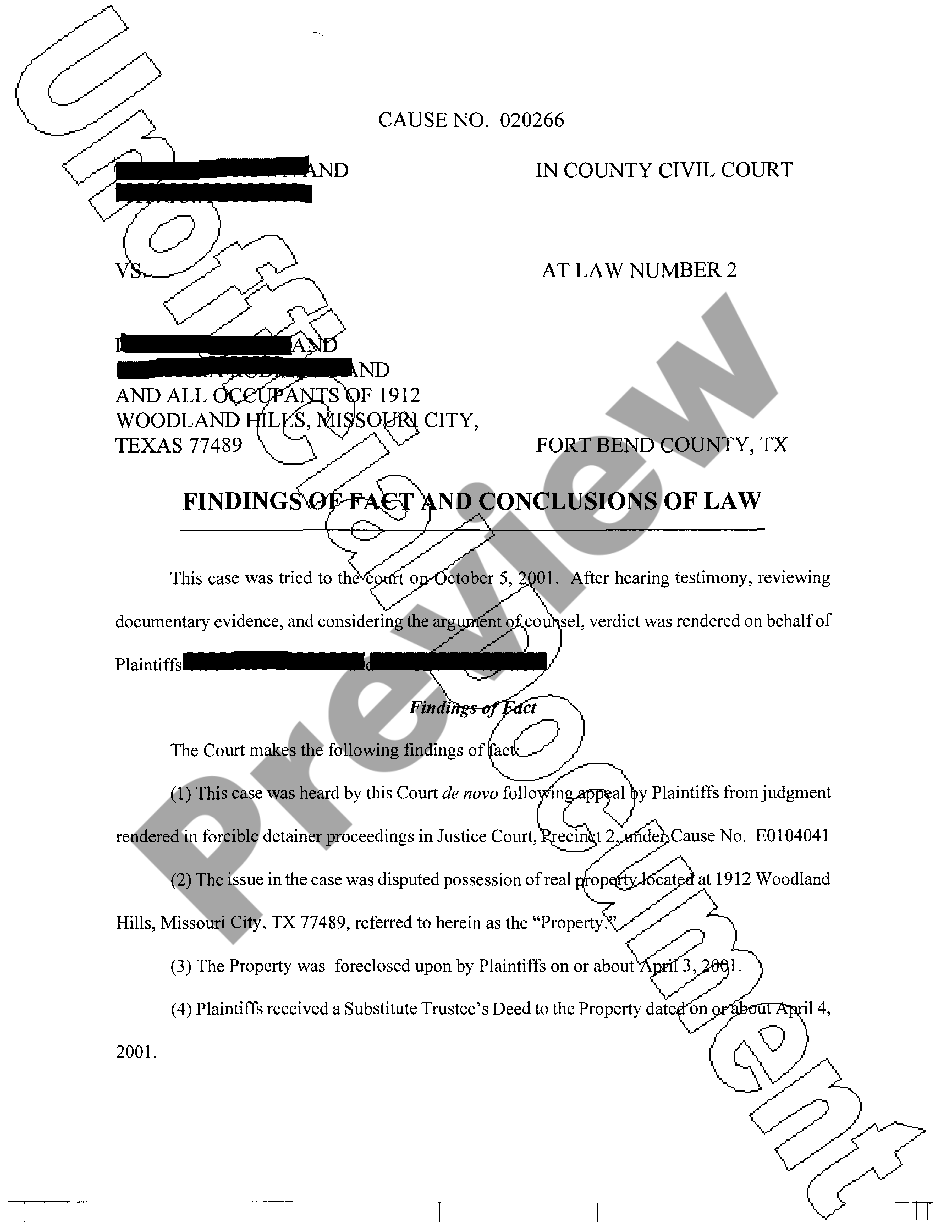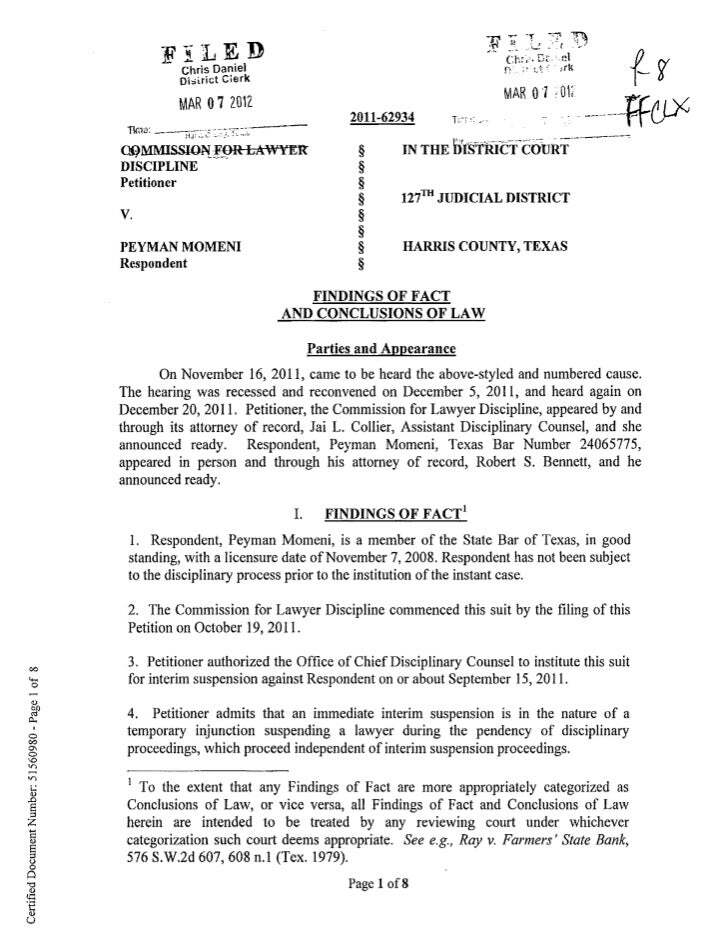Texas Findings of Fact and Conclusions of Law in Legal Proceedings
Findings of fact are crucial elements in legal proceedings, particularly in Texas law. They are statements that summarize the key facts established during a trial or hearing. These findings help the court make informed decisions based on the evidence presented. The judge typically makes findings of fact after considering witness testimonies, documents, and other relevant materials.
In Texas, findings of fact are particularly important in bench trials where there is no jury. The judge acts as both the fact-finder and the decision-maker. Understanding these findings can clarify how the court interprets evidence and arrives at its conclusions. Here are some key points to consider:
- They provide a factual basis for legal conclusions.
- They help parties understand the court’s reasoning.
- They can be challenged in appellate courts.
What Are Conclusions of Law

Conclusions of law refer to the legal principles or rules that the court applies to the established facts. Unlike findings of fact, which deal with the evidence and what happened, conclusions of law involve the interpretation of that evidence under the law. The judge formulates these conclusions based on the legal framework surrounding the case.
In Texas, conclusions of law help in determining how the law applies to the facts found. For example, if the court finds that a contract was breached, the conclusion of law may state that the injured party is entitled to damages. Key points to remember about conclusions of law include:
- They are based on the judge’s interpretation of the law.
- They guide the outcome of the case.
- They can be reviewed for legal correctness in appellate courts.
Importance of Findings of Fact and Conclusions of Law
Findings of fact and conclusions of law play vital roles in ensuring fair legal proceedings in Texas. Together, they create a clear framework for understanding how a court arrives at its decisions. Here’s why they are so important:
- Clarity: They provide clarity for all parties involved by outlining how the court interprets the facts and applies the law.
- Transparency: They enhance transparency in the judicial process, allowing parties to see the rationale behind the court’s decisions.
- Basis for Appeal: They serve as a basis for appeals. If a party believes there has been an error in the findings or conclusions, they can challenge them in a higher court.
In summary, findings of fact and conclusions of law are essential tools in the legal system, offering a structured approach to understanding court decisions. Their importance cannot be understated as they uphold the integrity of the judicial process.
How Findings of Fact Are Established
Establishing findings of fact is a fundamental part of any legal proceeding in Texas. These findings help clarify what the court has determined to be the truth based on the evidence presented during the trial. Typically, the judge makes these findings after carefully reviewing all relevant information. The process involves several key steps:
- Presentation of Evidence: Both parties present their evidence, which can include witness testimony, documents, and physical evidence.
- Credibility Assessment: The judge assesses the credibility of witnesses, determining who is believable and whose testimony holds weight.
- Legal Standards: The judge applies the appropriate legal standards to the facts to make determinations about each element of the case.
- Written Findings: Once the evidence is reviewed, the judge documents their findings in writing, outlining the key facts established during the trial.
This structured approach ensures that the findings of fact are not arbitrary but are based on thorough consideration of all relevant evidence. Ultimately, these findings lay the groundwork for the legal conclusions that follow.
Process of Creating Conclusions of Law
The process of creating conclusions of law follows the establishment of findings of fact. After the judge determines the facts of the case, they move on to apply the law to those facts. Here’s how this process generally unfolds:
- Review of Legal Principles: The judge reviews relevant statutes, case law, and legal precedents that apply to the established facts.
- Application of Law: The judge applies the law to the specific findings of fact to derive legal conclusions. This step is critical as it shapes the outcome of the case.
- Documenting Conclusions: The judge then documents their conclusions of law in writing, often included in the same document as the findings of fact.
- Explanation of Rationale: In some cases, the judge may provide explanations for their conclusions, offering insights into how the law was applied.
This process ensures that the conclusions are grounded in law and logically follow from the established facts, providing a clear rationale for the court’s decision.
Differences Between Findings of Fact and Conclusions of Law
Understanding the differences between findings of fact and conclusions of law is essential for anyone involved in legal proceedings. While they are closely related, they serve distinct purposes:
| Aspect | Findings of Fact | Conclusions of Law |
|---|---|---|
| Definition | Statements summarizing the evidence and what happened in the case. | Legal interpretations and applications of the established facts. |
| Who Determines | The judge (or jury) based on the evidence presented. | The judge, applying legal standards to the findings of fact. |
| Purpose | To clarify the factual basis for the court’s decision. | To explain how the law applies to those facts. |
| Reviewability | Can be challenged on appeal for insufficient evidence. | Can be reviewed for legal correctness in higher courts. |
In summary, findings of fact focus on the “what” of the case, while conclusions of law address the “how” and “why” related to legal principles. Both are crucial for a well-rounded understanding of judicial decisions.
How to Challenge Findings of Fact and Conclusions of Law
Challenging findings of fact and conclusions of law is an important part of the legal process, especially if you believe the court made an error. Whether you are a party to the case or representing someone else, understanding how to effectively challenge these components is crucial. Here’s how to approach it:
- Identify Errors: Begin by carefully reviewing the findings and conclusions. Look for inaccuracies, inconsistencies, or errors in the application of law.
- Gather Evidence: Collect any evidence that supports your claim that the findings or conclusions are incorrect. This may include witness statements, documents, or prior case law.
- File a Motion: You can file a motion for reconsideration or a motion to modify findings of fact and conclusions of law with the trial court. Make sure to state clearly what you are challenging and why.
- Appeal: If the motion is denied, you may have the option to appeal the decision to a higher court. This will typically involve filing a notice of appeal and presenting your arguments in a written brief.
Remember, challenges should be based on sound legal reasoning and supported by evidence. The process can be complex, so consulting with a qualified attorney is often beneficial.
Best Practices for Drafting Findings of Fact and Conclusions of Law
Drafting clear and precise findings of fact and conclusions of law is vital for ensuring that the court’s decisions are understood and can withstand scrutiny. Here are some best practices to consider:
- Be Clear and Concise: Use straightforward language. Avoid legal jargon that may confuse readers.
- Follow a Logical Structure: Present findings in a logical order, linking them directly to the evidence presented.
- Be Specific: Include specific details such as dates, names, and events to support each finding. This adds credibility to your document.
- Connect Facts to Law: Ensure that conclusions of law are clearly tied to the findings of fact. This helps demonstrate how the law applies to the situation.
- Review for Consistency: Double-check that your findings and conclusions are consistent with each other and with the evidence.
By following these best practices, you can create documents that clearly articulate the court’s reasoning and enhance the chances of your findings being upheld.
FAQ
What are findings of fact?
Findings of fact are statements by a judge that summarize the key facts established during a trial or hearing based on the evidence presented.
How do conclusions of law differ from findings of fact?
While findings of fact deal with what happened in a case, conclusions of law involve the application of legal principles to those facts.
Can I appeal findings of fact?
Yes, findings of fact can be appealed, typically on the grounds that they were not supported by sufficient evidence.
What is the purpose of drafting findings of fact and conclusions of law?
These documents clarify the court’s reasoning, provide a basis for appeals, and ensure transparency in the judicial process.
Is it necessary to have an attorney to challenge findings or conclusions?
While it’s not strictly necessary, having an attorney can greatly enhance your chances of successfully challenging findings of fact and conclusions of law.
Conclusion
In summary, understanding findings of fact and conclusions of law is essential for navigating the legal landscape in Texas. These components play a crucial role in shaping the outcomes of legal proceedings. By knowing how they are established, how to challenge them, and the best practices for drafting, individuals and legal professionals can better advocate for their interests. Whether you are a party to a case or involved in the legal profession, a firm grasp of these concepts will empower you to engage more effectively in the judicial process. As legal matters can be complex, seeking guidance from experienced attorneys can enhance your understanding and improve your chances of success in court.
